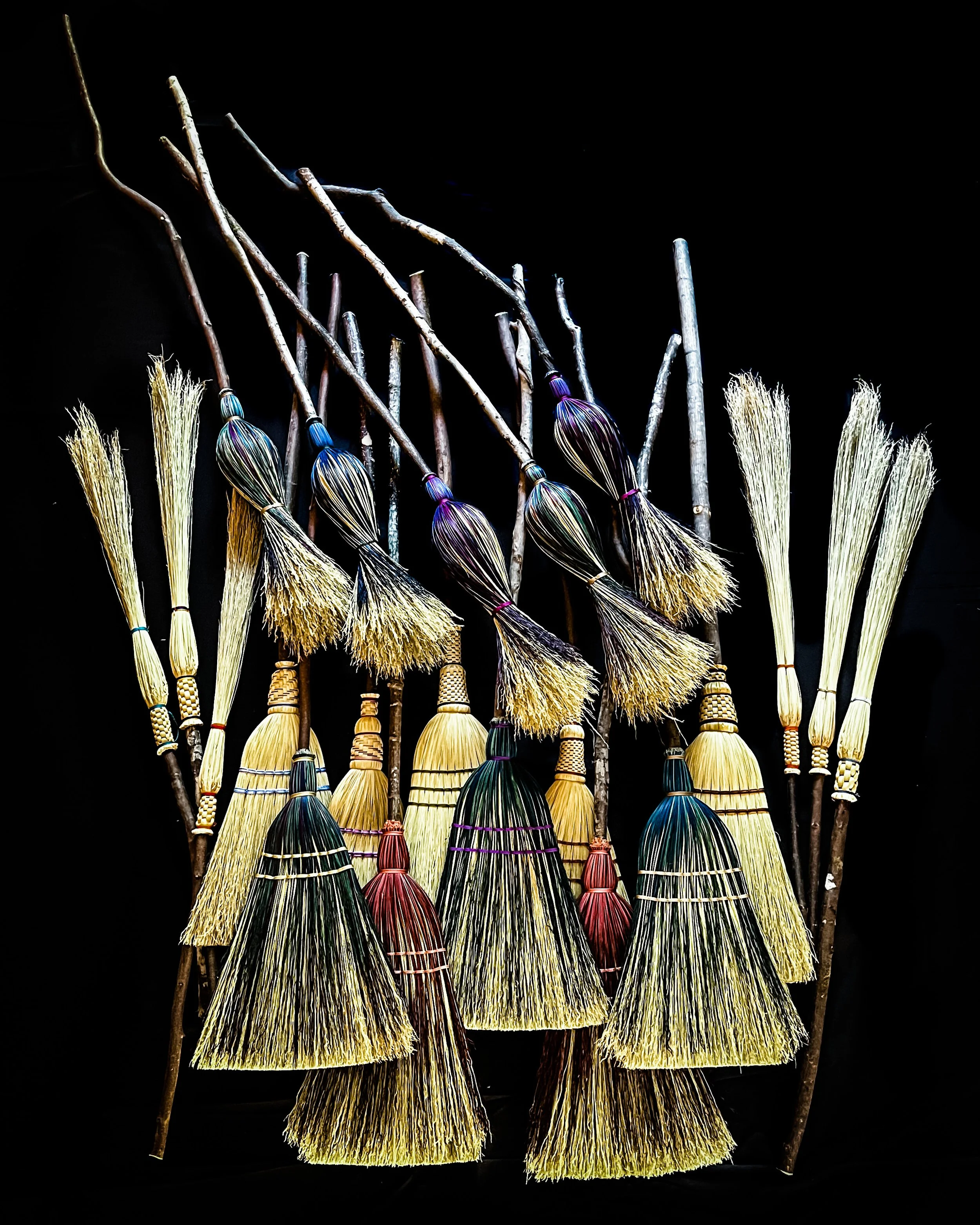SWEEPER: A full size broom with sculpturally built shoulders that broomcorn is layered over and then stitched flat. The flat stitching was an innovation by the Shakers in 1798. This is generally the most widely recognized style of contemporary brooms.
BESOM: A full size finished broom with the hurl stitched into a round shape and a woven cap. This is considered to be the oldest form of broom dating back thousands of years. It originated as a bundle of sticks tied to a handle. The modern version is much more refined and durable. This is also the style of broom most often associated with witches and magic.
CURVY BESOM: Similar to the original besom, but the hurl is twisted and structured to create an extra curvy silhouette.
HEARTH BROOM: A shorter handled broom with the broomcorn tension bound to the stick and then stitched flat, vaguely resembling a small sweeper.
PORCH BROOM: A shorter handled broom similar to the hearth broom, but stitched into a round besom like shape.
COBWEBBER: A long slender broom featuring untrimmed natural broomcorn with the stalks still attached and woven to the wooden handle. Originally from Appalachia and made for cleaning the high ceilings and eaves of mountain cabins.
KIDS FLYER: This broom is built for speed, long enough to ride on, but smaller than a full sized broom. The narrow shape is tension wound in a round shape, giving it a sleek look that is ready to jump into the sky.
SIMPLE WHISK: TURKEY WING - This whisk is tension wound while adding one section of broomcorn at a time creating an asymmetrical shape with the twine winding up one side of the broom and up the handle.
HAWK TAIL - Similar to the Turkey Wing, but you add your sections to each side as you wind the tension up the center of the broom, creating a symmetrical finish.
WOVEN WHISK: (simple turkey wing or simple hawk tail) This is a standard Simple Whisk that is finished by weaving stalks along the handle to create a detailed finished look.
ROUND WHISK: (wrapped or woven) This basic whisk design is made with a round bundle of broomcorn bound at the top with twine, and sometimes finished with a woven stalk handle.
STITCHED WHISK: (wrapped or woven) This broom starts as a round whisk and is then stitched flat and trimmed, giving it a classic triangular shape.
BRAIDED ROOSTER TAIL WHISK: This whisk is created one section at a time, much like the Turkey Wing. However, for each section you face down, you also weave a section up the handle, creating a braided effect. The handle is frequently embellished with winding or woven twisted broomcorn sections.
RAVENS TAIL WHISK: This is a diamond pointed whisk that has sections of broomcorn woven up the center creating a braided effect stemming from the middle of the bristle and climbing up the handle.
CROWS TAIL WHISK: This broom is similar to the Ravens Tail with the braided portion starting in the center of the bristle and moving up the handle, however the bristle is trimmed in a softer rounded shape.
CATHEDRAL WHISK: This is a stitched whisk with an overlay of intricately woven broomcorn decorating the top part of the whisk, and allowing lacy glimpses at the under layer of bristle. The weave is reminiscent of the peaked domes and stained glass windows of old cathedrals.
MIRRORED WHISK: This hand broom is made with a similar technique to the Turkey Wing Whisk, but two brooms are joined together at the handle to create a mirrored symmetrical silhouette.
GEMINI WHISK: This is another style of mirrored whisk made from two Rooster Tails joined at the handle with the braiding bordering the outsides of the broom, reaching from the tips all the way up to the handle.
SOLID WRAP: This is a type of tension winding a broom without leaving any space between the twine rounds creating a solid color blocked look.
BROOMCORN: This natural fiber is a type of sorghum grass with a feathery top originally cultivated as cropfeed for animals, but put to use early on in the Medditerranean as an efficient broom bristle. Broomcorn was brought to the Americas in the 1700's, and has become the primary natural broom fiber. The tufted tops are reminiscent of corn tassels, hence the name.
CRAFT BROOMCORN: This is the same sorgum plant, however the broomcorn is left on the stalk (so they can be woven onto the handle) and the feathery ends are not trimmed. This type of broomcorn is most commonly used for Cobwebbers.
HURL: The fiber that makes up the body and bristle of the broom. Most commonly made up of broomcorn in North America and Europe.
STITCHING NEEDLE: An extra strong stainless steel needle that is approximately six inches long to be able to push through the bristle. I commonly use upholstry needles.
STITCHING CLAMP: Two trim strips of wood bound together at both ends with a wingnut and a long bolt to make it adjustable. The body of the broom is clamped between the two pieces of would in order to hold it flat for stitching and trimming.
BROAD KNIFE: Flat wide knife with a rounded tip, a leather hilt, and a wooden handle. This knife is used for trimming and shaping the broomcorn.
FLORAL STEM CHOPPER: This table mounted cutter has a long heavy arm with an attached blade meant to bite through hardy materials and make a straight cut. I use this to trim the ends of the bristle to create a clean flat finish.


